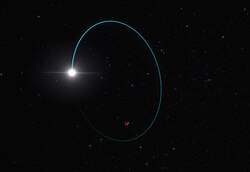| Observation data Epoch J2000 Equinox J2000 | |
|---|---|
| Constellation | Aquila |
| Right ascension | 19h 39m 18.71s[1] |
| Declination | +14° 55′ 54.01″[1] |
| Characteristics | |
| Star | |
| Evolutionary stage | Giant star |
| Spectral type | G |
| Black hole | |
| Evolutionary stage | Stellar black hole |
| Astrometry | |
| Radial velocity (Rv) | -333.2 ±3.4[2] km/s |
| Proper motion (μ) | RA: -28.317 ±0.067 mas/yr[2] Dec.: -155.221 ±0.111 mas/yr[2] |
| Parallax (π) | 1.6933 ± 0.0164 mas[2] |
| Distance | 1,930 ± 20 ly (591 ± 6 pc) |
| Orbit[2] | |
| Period (P) | 4,253.1±98.5 d |
| Semi-major axis (a) | 16.17 ± 0.27 AU |
| Eccentricity (e) | 0.7291 ±0.0048 |
| Inclination (i) | 110.580 ±0.095° |
| Longitude of the node (Ω) | 136.236 ±0.128° |
| Periastron epoch (T) | JD, TCB 2458177.39 ± 0.88 |
| Argument of periastron (ω) (secondary) | 77.34 ±0.76° |
| Details[2] | |
| Star | |
| Mass | 0.76±0.05 M☉ |
| Radius | 4.936 ± 0.016 R☉ |
| Surface gravity (log g) | 2.929 ±0.003 cgs |
| Temperature | 5212 ±80 K |
| Metallicity [Fe/H] | -2.56 ± 0.11 dex |
| Black hole | |
| Mass | 32.70±0.82 M☉ |
| Other designations | |
| Database references | |
| SIMBAD | data |
Gaia BH3 (Gaia DR3 4318465066420528000) is a binary system consisting of a metal-poor giant star with spectral type G and a stellar-mass black hole. Gaia BH3 is located 1926 light years away (590.6±5.8 pc away) in the constellation of Aquila. Gaia BH3 is the first black hole discovered from preliminary Gaia DR4 astrometric data.[2]
The black hole and star orbit the system barycentre every 11.6 years, with an orbital distance ranging from 4.5–29 AU.[3] The black hole's mass is 32.70 M☉, the heaviest known stellar black hole in the Milky Way.
The black hole Gaia BH3 is together with Cygnus X-1 the only known stellar black hole more massive than about 10 M☉. The mass of Gaia BH3 is quite similar to the mass of merging binary black holes found via gravitational waves. These massive black holes were suspected to be formed by metal-poor stars and the fact that Gaia BH3 has a metal-poor companion strengthens this conclusion.[2]
Gaia BH3 was found to be part of a disrupted star cluster of low mass and this star cluster is today a halo stellar stream, called ED-2. This stellar stream is very old, with an age comparable to the globular cluster Messier 92. This means that Gaia BH3 likely formed more than 13 billion years ago and the black hole might have formed via direct collapse of a massive star. Alternatively the black hole could have formed via binary interaction inside the star cluster. The ED-2 star cluster has a mass between 2,000 M☉ and 42,000 M☉.[4]
- ^ a b "LS II +14 13". SIMBAD. Centre de données astronomiques de Strasbourg.
- ^ a b c d e f g Cite error: The named reference
Panuzzo et alwas invoked but never defined (see the help page). - ^ Dunham, Will (April 16, 2024). "Astronomers detect Milky Way's second-largest known black hole". Reuters.
- ^ Cite error: The named reference
Balbinot2024was invoked but never defined (see the help page).
